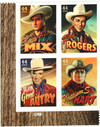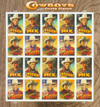
2010 44c Cowboys of the Silver Screen
# 4446-49 - 2010 44c Cowboys of the Silver Screen
$6.50 - $45.00
U.S. #4446-49
Cowboys of the Silver Screen
Cowboys of the Silver Screen
Issue Date: April 17, 2010
City: Oklahoma City, OK
Printing Method: Lithographed
Perforations: Serpentine Die Cut 10.5 x 10.75
Color: Multicolored
City: Oklahoma City, OK
Printing Method: Lithographed
Perforations: Serpentine Die Cut 10.5 x 10.75
Color: Multicolored
Please note: Due to the layout of the pane, the se-tenant may or may not be provided in Scott Catalogue order.
Roy Rogers
When Roy Rogers (1911-1998) was a child, his father brought home a cylinder player (the predecessor to the phonograph) and a cylinder by a Swiss yodeler. Roy played the cylinder again and again and developed his own style of yodeling. At the age of 18, Rogers moved to California to become a singer.
In the 1930s, Roy’s band, Sons of the Pioneers, began singing in Western films. His movie roles were small until 1935, when Gene Autry had a contract dispute with Republic Pictures. The studio held auditions for a singing cowboy to replace Autry in the upcoming movie, Under Western Stars. Roy didn’t have an appointment, so he mingled in with a crowd of movie extras and sneaked onto a lot. The producer loved Roy’s singing, and gave him the starring role.
For his horse in the film, Roy chose a palomino named Golden Cloud. A fellow actor mentioned how quick on the trigger the horse was. Rogers agreed and changed the horse’s name to Trigger. The two went on to star in over 80 movies together.
Nicknamed “King of the Cowboys,” Roy became an idol to millions of children. In recognition of his achievements in radio, music, film, and television, Roy received four stars on the Hollywood Walk of Fame.
Tom Mix
Tom Mix (1880-1940) was a true cowboy. Attracted to ranch life at a young age, Mix worked hard on his roping and riding skills, and by 1909 he was a national riding and rodeo champion.
Mix was a natural showman whose talents on horseback earned him a small part as a cattle wrangler in the movie Ranch Life in the Great Southwest. During filming, Mix talked the director into letting him do a bronco busting scene, and the rest is history.
In the 1920s, audiences wanted more action in Western films, and Mix gave it to them. Landing his first starring role in The Untamed, Mix and his horse Tony performed all their own stunts. His movies filled with cowboy shootouts and daredevil stunts, Mix became Hollywood’s first action hero.
Mix was also the first Western star to make his horse a sidekick. Many of his films showcased the talents of the “Wonder Horse” Tony – making him the most popular horse in the world. Every week, Tony received thousands of cards and letters from children.
Wearing elaborate outfits, Mix thundered across the prairie in pursuit of the bad guys. For over two decades, Tom Mix had the most action-packed cowboy scenes on the silver screen.
William S. Hart
William S. Hart (1864-1946) was in his teens when he moved to New York City to become a stage actor. By the 1890s, he was one of the leading Shakespearean actors on Broadway. But it was Western plays, such as The Squaw Man and The Virginian, that Hart enjoyed the most.
In 1914, Hart moved to Hollywood to act in motion pictures. After playing supporting roles in two short films, he starred in the feature film The Bargain. Hart portrayed the “good” bad man – a cowboy who would fight, gamble, and steal, but was also kind, honest, and caring.
Hart insisted on showing the real Old West in his films. He went so far as to use real Indians, gamblers, prostitutes, and saloon entertainers in his movies. His gritty depiction of the Wild West was new and refreshing to moviegoers. This made him one of the most popular Western heroes of the silent movie era.
In 1925, Hart produced Tumbleweeds, a nostalgic look at the closing of the Old West. The movie is regarded as one of the greatest silent Westerns every made. In 1939, Tumbleweeds was reissued with a spoken introduction by Hart. The speech turned out to be his farewell to the silver screen.
Gene Autry
In 1926, Gene Autry (1907-1998) was working as a telegraph operator when humorist Will Rogers overheard him singing. Rogers told Gene he was good enough to sing on the radio. Gene followed his advice and earned a spot on the radio show National Barn Dance as Oklahoma’s “Yodeling Cowboy.”
In 1934, Autry was cast in the film In Old Santa Fe. He only had one scene, where he sang a song and called a square dance, but his next appearance was much more important – starring in the 12-chapter movie short The Phantom Empire.
The following year Autry starred in Tumbling Tumbleweeds, which made him a household name and ushered in the era of the “singing cowboy.” The movie introduced a successful formula where Autry played himself. With the help of his sidekick Smiley and his horse Champion, Autry tracked down the bad guys and brought them to justice.
Known as “America’s Favorite Singing Cowboy,” Autry is the only entertainer to have five stars on Hollywood's Walk of Fame. Autry was the ultimate role model. He promoted clean living through his “Cowboy Code” – 10 virtues promoting an ethical, moral, and patriotic lifestyle. Through his movies, Autry entertained and inspired people throughout the world.
U.S. #4446-49
Cowboys of the Silver Screen
Cowboys of the Silver Screen
Issue Date: April 17, 2010
City: Oklahoma City, OK
Printing Method: Lithographed
Perforations: Serpentine Die Cut 10.5 x 10.75
Color: Multicolored
City: Oklahoma City, OK
Printing Method: Lithographed
Perforations: Serpentine Die Cut 10.5 x 10.75
Color: Multicolored
Please note: Due to the layout of the pane, the se-tenant may or may not be provided in Scott Catalogue order.
Roy Rogers
When Roy Rogers (1911-1998) was a child, his father brought home a cylinder player (the predecessor to the phonograph) and a cylinder by a Swiss yodeler. Roy played the cylinder again and again and developed his own style of yodeling. At the age of 18, Rogers moved to California to become a singer.
In the 1930s, Roy’s band, Sons of the Pioneers, began singing in Western films. His movie roles were small until 1935, when Gene Autry had a contract dispute with Republic Pictures. The studio held auditions for a singing cowboy to replace Autry in the upcoming movie, Under Western Stars. Roy didn’t have an appointment, so he mingled in with a crowd of movie extras and sneaked onto a lot. The producer loved Roy’s singing, and gave him the starring role.
For his horse in the film, Roy chose a palomino named Golden Cloud. A fellow actor mentioned how quick on the trigger the horse was. Rogers agreed and changed the horse’s name to Trigger. The two went on to star in over 80 movies together.
Nicknamed “King of the Cowboys,” Roy became an idol to millions of children. In recognition of his achievements in radio, music, film, and television, Roy received four stars on the Hollywood Walk of Fame.
Tom Mix
Tom Mix (1880-1940) was a true cowboy. Attracted to ranch life at a young age, Mix worked hard on his roping and riding skills, and by 1909 he was a national riding and rodeo champion.
Mix was a natural showman whose talents on horseback earned him a small part as a cattle wrangler in the movie Ranch Life in the Great Southwest. During filming, Mix talked the director into letting him do a bronco busting scene, and the rest is history.
In the 1920s, audiences wanted more action in Western films, and Mix gave it to them. Landing his first starring role in The Untamed, Mix and his horse Tony performed all their own stunts. His movies filled with cowboy shootouts and daredevil stunts, Mix became Hollywood’s first action hero.
Mix was also the first Western star to make his horse a sidekick. Many of his films showcased the talents of the “Wonder Horse” Tony – making him the most popular horse in the world. Every week, Tony received thousands of cards and letters from children.
Wearing elaborate outfits, Mix thundered across the prairie in pursuit of the bad guys. For over two decades, Tom Mix had the most action-packed cowboy scenes on the silver screen.
William S. Hart
William S. Hart (1864-1946) was in his teens when he moved to New York City to become a stage actor. By the 1890s, he was one of the leading Shakespearean actors on Broadway. But it was Western plays, such as The Squaw Man and The Virginian, that Hart enjoyed the most.
In 1914, Hart moved to Hollywood to act in motion pictures. After playing supporting roles in two short films, he starred in the feature film The Bargain. Hart portrayed the “good” bad man – a cowboy who would fight, gamble, and steal, but was also kind, honest, and caring.
Hart insisted on showing the real Old West in his films. He went so far as to use real Indians, gamblers, prostitutes, and saloon entertainers in his movies. His gritty depiction of the Wild West was new and refreshing to moviegoers. This made him one of the most popular Western heroes of the silent movie era.
In 1925, Hart produced Tumbleweeds, a nostalgic look at the closing of the Old West. The movie is regarded as one of the greatest silent Westerns every made. In 1939, Tumbleweeds was reissued with a spoken introduction by Hart. The speech turned out to be his farewell to the silver screen.
Gene Autry
In 1926, Gene Autry (1907-1998) was working as a telegraph operator when humorist Will Rogers overheard him singing. Rogers told Gene he was good enough to sing on the radio. Gene followed his advice and earned a spot on the radio show National Barn Dance as Oklahoma’s “Yodeling Cowboy.”
In 1934, Autry was cast in the film In Old Santa Fe. He only had one scene, where he sang a song and called a square dance, but his next appearance was much more important – starring in the 12-chapter movie short The Phantom Empire.
The following year Autry starred in Tumbling Tumbleweeds, which made him a household name and ushered in the era of the “singing cowboy.” The movie introduced a successful formula where Autry played himself. With the help of his sidekick Smiley and his horse Champion, Autry tracked down the bad guys and brought them to justice.
Known as “America’s Favorite Singing Cowboy,” Autry is the only entertainer to have five stars on Hollywood's Walk of Fame. Autry was the ultimate role model. He promoted clean living through his “Cowboy Code” – 10 virtues promoting an ethical, moral, and patriotic lifestyle. Through his movies, Autry entertained and inspired people throughout the world.
















